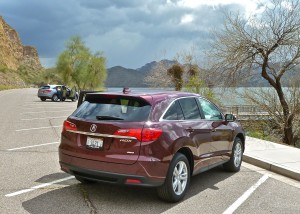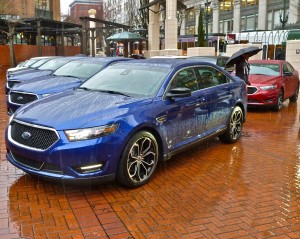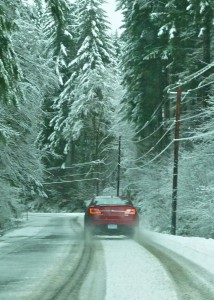Acura RDX undergoes smooth refinement
By John Gilbert
When Honda decided to grace its upscale Acura line with a compact crossover SUV for the 2007 model year, it rolled out the RDX, which was an impressive sports-car-like performer amid a sea of more mundane competitors. That sea has experienced a remarkable rising tide during the past five years, so it’s time for a new RDX that is both an impressive performer and a bit of a contradiction on wheels.
The new design is considerably smoother, playing off the just-introduced Honda CR-V with a distinctly upgraded spin to set it apart from its mainstream sibling. It discards the high-performance turbocharged 4-cylinder engine for the smooth and powerful 3.5-liter V6 that powers the Acura TSX sedan and the Honda Accord and Odyssey van. Handling and connectivity features are among focus points of the new RDX, which has lost the harshness of the first generation’s ride without sacrificing the firm cornering feel.
The new RDX will have base prices of $34,320 for front-wheel-drive models, and $35,720 for a new and more-sophisticated all-wheel-drive system. Built at the East Liberty, Ohio, plant, the RDX will compete with the BMW X3, Audi Q5, Mercedes GLK 350, and Infiniti EX35, according to Acura, but the proliferation of compact crossovers might also throw the Volvo XC-60, Range Rover Evoque, Volkswagen Tiguan, Chevrolet Equinox, GMC Terrain, Ford Edge, Toyota RAV4, Nissan Murano, Hyundai Santa Fe, Kia Sorento, Mazda CX-7 — and its new replacement, the CX-5 — into the fray.
Curiously, while such major players as BMW, Mercedes, Mazda, and Hyundai are proving that switching from six cylinders to four can reduce fuel consumption, and gaining sufficient power from applications of turbocharging in some instances, Acura, which was among the first to try that concept with the first RDX, now is going the other direction — from four to six cylinders — in search for the same improvement in fuel economy.
Jeff Conrad, the Acura vice president, explained that projecting “Generation Y” buying habits have changed from what Honda’s market research had previously projected. “Gen Y is the first generation to earn less money than their parents,” Conrad said. “Luxury vehicles involve emotion, because you’re buying a vehicle not because you have to, but because you want to — and you can.
“But value is now a top priority, and buyers are less interested in horsepower and size, which will cause a fundamental change in the luxury car market. Acura has unique core values, focusing on the driver more than just the machine, on connective technology, and on sustainability. We will remake our whole line with those priorities.” Read more
Ford relaunches Taurus, refines Flex
By John Gilbert
The completely redone Ford Fusion won’t reach showrooms until late summer, but its flashy restyling has been the talk of the auto show circuit. In fact, it may be the reason Ford created an all-new Taurus ahead of its time.
The 2013 Taurus is a car for all reasons for those who need, or want, a large car. And it also is a car for all seasons with available all-wheel-drive, for those living in the snow-belt, or, a the introduction session proved, for those living in non-snow regions that occasionally might get blindsided by a blizzard.
When the midsize Fusion was shown at the Detroit Auto Show, one cynic suggested that if the rear seat-room was adequate, there would be no need to continue building the larger Taurus. The new Fusion’s rave reviews made the new-for-2010, and still new-looking, Taurus seem outdated before its time.
The considerable expense of rebuilding a next-generation car is what causes automakers to build a model to last five or more years, perhaps with only a mid-term cosmetic refreshing, but Ford went against conventional planning. As Ford’s flagship, the Taurus meets the demands for a large sedan to take on the armada of General Motors large cars, as well as Chrysler, European, and now Asian big cars. So even though the current Taurus was only going into its third model year, Ford introduced another entirely new Taurus as a 2013 model. It was a brilliant move.
The new Taurus smoothes out a few of the contours that looked so fresh just two years ago, and the car takes on a lower and sleeker look with a cousin-like resemblance to the upcoming Fusion. Taurus adopts a Fusion-shaped grille, which apparently will establish it as a new corporate signature. The top-of-the-line Taurus again will be the SHO model, which is loaded with performance features and begins at a lofty $39,200. The one we drove was loaded up to an even loftier $44,485 with voice-activated navigation and 20-inch painted aluminum wheels.
A subtle benefit of short-shifting the renewal is that the current Taurus, which is a very good and handsome sedan, so the renovation didn’t require tossing out everything and starting with a clean sheet. In the Taurus’s case, Ford designers and engineers could work with an already-impressive vehicle, and small alterations or tweaks were aimed at smoothing out features, polishing the interior, and making the Taurus go, handle and ride better and more quietly. The finished product improves the appearance, and is filled with upgrades inside and out.
That wasn’t Ford’s only recent maneuver; the company is revising the look of the stylishly square Flex as well. Ford introduced both the Taurus and Flex for 2013 to the automotive media in Portland, Oregon, in mid-March. That plan made sense at planning time, because back at Ford’s home, Detroit, and throughout the rest of the Upper Midwest, early March is normally still in the grip of winter, while Portland promises moderate temperatures despite a little rain.
Ah, but 2012 began with the Upper Midwest’s “non-winter,” and while Minnesota, for example, was recording a couple of weeks of record lamb-like warm temperatures — 60s and 70s even — Portland’s weather was remarkably the opposite and lionish. We drove from downtown Portland in a steady, day-long rainstorm and headed toward the Pacific Coast. Driving up some suburban foothills, we found that the steady rain turned to snow, hanging heavily in white majesty from the fir trees as we went to higher elevation.
It was perfect timing, because both the new Taurus and Flex make all-wheel drive available. The Tauruses we test-drove were, in fact, the hot-performing SHO models. Newer Ford folks say “Show,” in referring to the SHO, while more veteran observers recall the original came out in 1989 and the name was the initials for “Super High Output,” for the gem of a V6 engine that was built specifically for the car by Yamaha. Later, Yamaha built Ford a V8 for the car.
The new SHO also has a V6, but no longer a V8. Ford’s latest technology has been to mount turbochargers on its 3.5 V6 and create more power and performance than a larger V8, while also improving fuel economy. The Taurus will have three engines available, starting with a 2.0-liter 4-cylinder EcoBoost, then the normally-aspirated 3.5 V6, and topped by the EcoBoost 3.5 V6. The power range shows the 2.0 EcoBoost is turbocharged up to 240 horsepower and 270 foot-pounds of torque, while still boasting an EPA estimate of 31 highway miles per gallon. The normal 3.5 V6 has 288 horsepower and 254 foot-pounds of torque, and a range of 19 mpg city and 29 highway.
If you select the SHO, you get the EcoBoost, which has two turbochargers and direct injection, and the power takes a quantum leap to 365 horsepower and 350 foot-pounds of torque, with fuel economy estimates of 17 city, 25 highway. Not sensational fuel economy, but very good consider that the SHO has a lot of power for a V8, and startling potency for a V6. Read more






 John Gilbert is a lifetime Minnesotan and career journalist, specializing in cars and sports during and since spending 30 years at the Minneapolis Tribune, now the Star Tribune. More recently, he has continued translating the high-tech world of autos and sharing his passionate insights as a freelance writer/photographer/broadcaster. A member of the prestigious North American Car and Truck of the Year jury since 1993. John can be heard Monday-Friday from 9-11am on 610 KDAL(www.kdal610.com) on the "John Gilbert Show," and writes a column in the Duluth Reader.
John Gilbert is a lifetime Minnesotan and career journalist, specializing in cars and sports during and since spending 30 years at the Minneapolis Tribune, now the Star Tribune. More recently, he has continued translating the high-tech world of autos and sharing his passionate insights as a freelance writer/photographer/broadcaster. A member of the prestigious North American Car and Truck of the Year jury since 1993. John can be heard Monday-Friday from 9-11am on 610 KDAL(www.kdal610.com) on the "John Gilbert Show," and writes a column in the Duluth Reader.